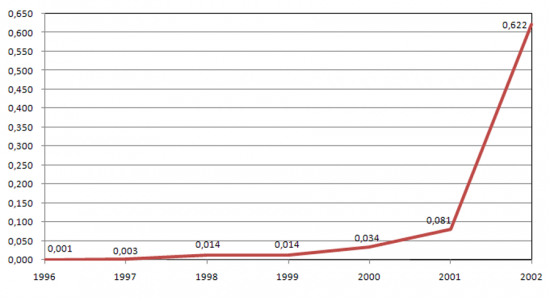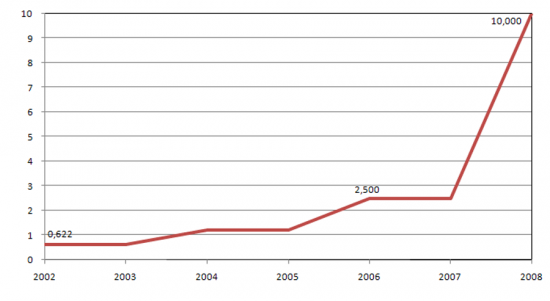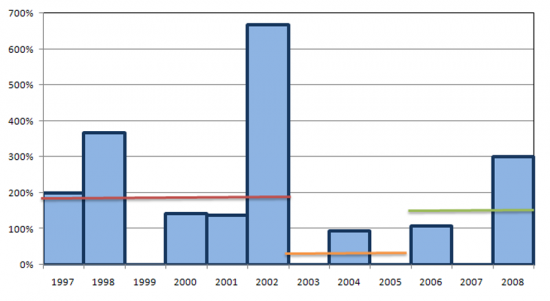

 e-Science
e-Science  Projects
Projects  Science and Education Network
Science and Education Network Science and Education Network
The RCTS – Science, Technology and Society Network is a computation network linking scientific and education research institutions. It also provides the connection to the international research and education network and is operated by the FCCN - Foundation for National Scientific Computation (site in Portuguese), a not-for-profit association whose activities are for the most part funded by Knowledge Society Agency (UMIC). The Science and Technology Foundation (FCT), Knowledge Society Agency (UMIC) , CRUP - Council of Vice-Chancellors of Portuguese Universities and LNEC - National Civil Engineering Laboratory, IP are associates.
The bandwidth for international connections to RCTS was more than doubled in 2005, reaching 2.5 Gbps, and the bandwidth between Lisbon and Braga rose from 1 Gbps to 10 Gbps, after the installation and purchase by the FCCN of a fibre-optic connection between the two cities, enabling 10 Gbps connections for the 7 biggest universities – Universidade de Lisboa, Universidade Técnica de Lisboa, Universidade Nova de Lisboa, Universidade de Coimbra, Universidade de Aveiro, Universidade do Porto and the Universidade do Minho – and therefore to 60% of the higher education system and 78% of the universities with research units approved in international evaluations sponsored by the FCT (size judged by the number of students enrolled), and also enlarging the bandwidth for the polytechnic institutes of Porto and Coimbra.
The Portugal - Spain Summit of November 2005 saw the two countries agree to complete their fibre-optic research and education networks up to the respective Alentejo-Extremadura and Minho-Galiza borders, so as to provide a redundant 10 Gbps fibre connection ring with mutual advantages in terms of the increase in the international broadband connection and guaranteed connections if there were a cut in the line. The first connection was completed in mid-2007 and the second in 2008 with the Lisbon-Setúbal-Évora-Portalegre-Fronteira do Caia stretch. These extensions provided the Universidade de Évora and the polytechnic institutes of Viana do Castelo, Setúbal and Portalegre with FCCN fibre-optics connections.
In January 2006, all elementary and secondary schools had a broadband connection to RCTS. Portugal was thus one of the first European Union countries to provide all elementary and secondary schools with broadband connections, just as it had been a pioneer in connecting all schools to the Internet via RDIS in 2001.
RCTS international connection bandwidth was quadrupled in July 2008. RCTS was connected at 10 Gbps to the European Union’s GÉANT2 network, thus solving the problem that had persisted for some years whereby Portugal was the only EU15 country, with the exception of Greece, without access to this bandwidth for connecting to the research and education networks of the other countries. A fibre-optic extension to RCTS to all district capitals is being prepared, thus enabling all state higher education institutions to enjoy this connection type.
With the conclusion of the Lisbon to Fronteira do Caia connection, the border with Spanish Extremadura, the institutions connected via the fibre-optic cable belonging to the FCCN equated to more than 70% of Portugal’s higher education system (size by number of students enrolled).
RCTS fibre-optic cable trajectory:

RCTS is the first New Generation Network set up in Portugal. In addition to the infrastructure enabling 10 Gbps communications, and with the FCCN's own fibre-optic cable covering roughly 950 km, RCTS has incorporated a sizeable selection of advanced broadband services:
- b-on Knowledge Library Online and Web of Knowledge
- GRID Computation
- Security and privacy
- e-U: Virtual Campus
- Video Streaming – Live and On Demand (text in Portuguese)
- VoIP and Video Conferencing
- Zappiens – High definition video repository and digital copyright management (site in Portuguese)
- Open Access Scientific Repository of Portugal
UMIC instituted a major shake-up of the RCTS funding model and availability in 2007. The previous model had been based on central funding for slightly over half the national contribution for costs and shared funding to be made up by the “consortium” of public and private “user" institutions, for the most part universities. There were several disadvantages to this model:
- The overwhelming majority of user institutions are state higher education institutions and science and technology institutions (roughly 95% of the attribution of total costs). Thus the liberal idea of these users participating in the subscription costs made no sense at all in the current situation given that: (1) there was no intention of moderating the use of these resources in terms of traffic by research and education networks – in fact the opposite was true, (2) funding for state higher education bodies comes from central public resources so “consortium" co-funding would not save any public resources, (3) the public management costs were higher in the model that had been adopted due to the administrative work created at the different user institutions and even more so at the FCCN where work dedicated to making sure the institutions paid up was significant and required the allocation of human resources throughout the year. In other words, the administrative costs for this pseudo-liberal method were greater than for a model whereby public funding would be provided centrally.
- Due to the costs that needed to be paid from higher education institutions’ budgets, several public institutions did not subscribe to RCTS or subscribed to bandwidths that severely restricted usage needs.
- The fact that the FCCN had a significant fibre-optic infrastructure of its own, and had done so since 2005, gave rise to the situation whereby the bandwidth available to institutions directly linked to this infrastructure could be upped considerably for research and education network traffic without any significant increase in the total costs.
The new funding model, which has been in force since 2007, involves central public funding of the costs allocated to public institutions of 5.5 million Euros from the Knowledge Society Agency (UMIC) budget.
At the same time, the funding model was simplified, thus eliminating the aforementioned problems. The public administrative and collection costs were slashed from one day to the next, as were the artificial limitations on bandwidth subscription. As an additional benefit and virtually without any cost increases, RCTS access was provided to all state higher education institutions and all state laboratories and research units approved under the Science and Technology Foundation (FCT), international evaluation system. Some of these institutions had not previously used RCTS. The aggregate bandwidth available to higher education institutions was also significantly raised from 1.8 Gbps in 2006 to 10 Gbps at the start of 2008.
RCTS was set up in 1997, extending the former National Scientific Computation Network (RCCN), which covered state universities only. RCTS was now able to provide access to all higher education institutions, state laboratories and other public or public interest scientific and technology research institutions, elementary and secondary schools, public libraries, museums, and scientific, educational and cultural associations.
In this way a holistic scientific, technological and educational system network was formed - a Knowledge Network.
In 1997, the FCCN connected all the approximately 1,750 5th to 12th year schools to the Internet. It connected 1st cycle schools over the course of the following years, its objective being to provide all 8,600 schools in this cycle with an Internet connection by the end of 2001.
All state universities were connected to RCTS in February 2002, thereby providing connections to 335 research units, 9 private universities, virtually all polytechnic institutes, the majority of state laboratories, all 5th to 12th year schools, all 1st to 4th year schools, every single one of the 180 teacher training centres, all public libraries (roughly 310), 32 museums and approximately 200 associations and other bodies.
International RCTS connectivity has risen progressively: 1 Mbps to 622 Mbps from January 1997 to March 2002 in several increments, rising to 1.2 Gbps in January 2004, where it stayed until October 2005 when it was doubled to 2.5 Gbps, and quadrupled to 10 Gbps in July 2008.
Knowledge Society Agency (UMIC) provides the public funding for RCTS and monitors its growth and operation.




